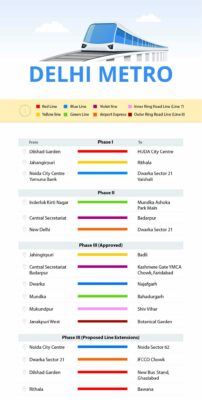If you’ve ever tried rushing from a meeting in Noida to catch a flight out of Delhi, you’ll know that the Delhi traffic is not to be taken lightly. And rightly so, because Delhi has more cars than Mumbai, Chennai and Calcutta put together. In 2011-2012, there were 74 lakh cars registered just within Delhi, not counting the NCR area, and the number was still growing. That’s four times the number of cars on the road in Mumbai. So although Delhi has lovely wide roads, traffic snarls make moving around the city quite difficult.
However, lovely wide roads are perfect for another form of transport: a metro rail. Wider roads make building metro rails considerably less disruptive to the traffic flow below than if the roads were narrow. And a metro can take some of the load off the road, leaving the roads traffic jam free.
So Delhi got itself a metro that would connect the different wings of the city (and its already existing train systems) in a fast, convenient manner and more importantly, would take some of its 7 million cars off its roads. And they didn’t skimp on anything while planning it.
The Metro
Delhi’s metro system is an extensive four phase network, in planning since the mid ‘eighties and the careful planning shows. Phases one and two are already operational, consisting of six lines that span the entire city, with more extensive plans in the works. Its focus on the future growth of the city while planning has won it the distinction of being a trendsetter for other metros in the South Asia region. Not a common boast in the land of ex-post facto development.

The proposed lines for phases III and IV are still awaiting approval and are set to be finished by 2021. Both phases will serve to provide access to the parts of the city still inaccessible by the Metro. The plans, however, go further: once completed, Delhi’s metro will link the city to all the other cities that fall under the NCR region.

Here’s a quick close-up of the approved areas Delhi’s Metro will cover by the completion of phase 3.


The planning shows elsewhere too: feeder buses run from each station, connecting the metro with other other forms of public transport in the city. Certain stations also connect the metro to the city’s ring rail system and to the Indian Railway lines that run through the city. Most stations have ATMS, convenience stores and mobile recharge shops and navigation information for the different Metro lines are available on Google Transit.

In fact, the metro even has apps for both Android and iOS phones, serving to provide information about the nearest metro station to a person, fare, parking availability and tourist spots near the station. Everything, in short, a commuter could possibly want; groceries on the way home, easy switches from line to line and most importantly, convenience and comfort.
The trains are pretty impressive too, equipped with noise absorbing cushions, vibration free coaches and with climate control facilities to regulate both temperature and humidity. Phase II trains even have plugpoints for charging laptops and phones while travelling. And lets not forget the women-only coaches with security guards travelling in them, completely revolutionizing transport for women in Delhi.

The metro and the city
The metro isn’t just good for travel though. It’s main aim was to reduce the number of cars plying the roads every day in Delhi – and so it does. Less cars = less smog = less pollution and cleaner air. But its environment friendliness extends far beyond mere pollution reduction. Its regenerative braking systems save the country 400, 000 carbon credits a year and now they’re looking to reduce the metro’s reliance on non-renewable energy resources even further by using solar power. And let’s not forget that most of the stations along the Metro’s Blue Line all harvest rainwater for the city. No more worrying about droughts anymore here.
And there’s one more thing the metro’s good for: real estate prices. Investors in real estate here don’t follow the money; they follow the railways tracks. Over the years the metro was built, prices along the lines have increased and interestingly, the increase has actually closed the gaps between prices in the periphery and the center of the city.

Over time, residential property value has appreciated by a little more than 11 per cent and the increase in value is even greater for commercial properties. Add this to all the other little economic benefits that come tagging along with the metro: grants for development near the area, economic development following the lines of transport, the DMRC’s own property developments in the area. The metro isn’t just a metro, it’s an artery, injecting life into the city’s economy.
So the next time you’re trying to get from a meeting in Noida to catch a flight out, don’t bother with a noisy, smelly, oil-guzzling car. Use the metro and rest assured in the knowledge that you’re just doing your civic duty. And saving yourself lots of trouble.






